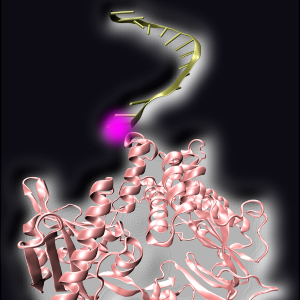PCR: Activated by light
14 Dec 2021
A new approach by LMU biochemists could help to significantly improve diagnostic tests based on PCR. The enzymes used are triggered by light pulses.
14 Dec 2021
A new approach by LMU biochemists could help to significantly improve diagnostic tests based on PCR. The enzymes used are triggered by light pulses.

© Vera / LMU
DNA polymerases and other enzymes that modify DNA are essential tools in biotechnology and diagnostics. They are the key component for COVID-19 diagnostics by PCR. As useful as they are, DNA processing enzymes often have important flaws. Some of them display significant activity during the preparation of the samples, while others have nasty secondary activities. Both can lead to loss of specificity and sensitivity, which has to be avoided in a diagnostic test.
The trick is to block any type of enzymatic activity until the assay starts. For diagnostics tests based on PCR, such as the above mentioned test for COVID-19, the solution is the development of a hot-start enzyme, which shows no activity until a high activation temperature is reached. The main drawback of these hot-start approaches is that they cannot be used for enzymes that are damaged by heat, says LMU-biochemist Andrés Vera. “Besides, the design of a hot-start enzyme is tedious and the exhausting design process has to be repeated for each new enzyme that we want to engineer.”
Together with Merve-Zeynep Kesici from the group of Prof. Philip Tinnefeld at the Department of Chemistry of LMU Andrés found a way around these problems designing light-start enzymes. Their light-start enzymes are blocked until a pulse of UV light reactivates them. “Light-controlled enzymes have been around for quite a while, but what makes our approach unique is that it can be applied to virtually any DNA processing enzyme. In the past you always needed very detailed information on how your enzyme works and you were never sure that you would come with a smart way to block the enzyme and reactivate it with light”, says Vera, leader of the project.
In their approach, the researchers bound a piece of DNA to the enzyme itself, which over-compete any other enzymatic substrates rendering the enzyme effectively inactive (including their secondary activities). The light pulse is used to cut the DNA attached to the enzyme resulting in a 100% active enzyme. The main advantage is that the mechanism should work for a broad range of DNA biding enzymes regardless of their specific way of action.
This is definitely going to help to produce better enzymes for biotechnological and diagnostics use.Prof. Philip Tinnefeld
To prove their point the researchers produced four light-activatable versions of different DNA processing enzymes. Among them was the so called Phi29 DNA polymerase, an enzyme broadly used to amplify whole genomes but too heat-sensitive to be adapted to hot-start methods. Moreover, the team showed light-start PCR and proved that their DNA polymerases were as good or better compared to commercial hot-start enzymes for PCR. Philip Tinnefeld is positive about this new development: “This is definitely going to help to produce better enzymes for biotechnological and diagnostics use. Besides, current real-time PCR machines already incorporate light sources and they could be easily modified to bring these enzymes to the market anytime soon.”
Merve-Zeynep Kesici, Philip Tinnefeld, Andrés Manuel Vera. A simple and general approach to control the activity of DNA processing enzymes. Nucleic Acids Research 2021.